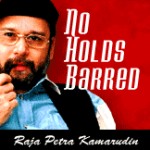How politicians hijack revolutions

Never mind which revolution you are talking about, the stories are all the same. Politicians are not capable of starting revolutions. The people start revolutions and then politicians hijack the revolution. The politicians hijacked the people’s revolution of 10th November 2007 and they will hijack the 9th July 2011 revolution as well if we are not careful.
NO HOLDS BARRED
Raja Petra Kamarudin
The French Revolution, the Russian Revolution and the Iranian Revolution are the more interesting revolutions to look at. Most of its leaders were in hiding or were not in the country and living in exile. They were not capable of organising anything in the country (especially back then when there were no mobile phones or internet like now).
Most of what happened was unplanned and took even the revolutionaries by surprise. Nevertheless, when the revolution did happen, this created a vacuum, which made it possible for the politicians to just walk in and take over.
Of course, once they took over, they rewrote the history books and painted a different picture of what really happened. Those who were in hiding or in exile overseas suddenly became the heroes of the revolution. And most times these ‘hijackers’ arrested and imprisoned or assassinated the real revolutionaries.
Let me quote some excerpts from Alan Bullocks’s 1,000-page book: Hitler and Stalin, Parallel Lives.
Contrary to later legends, the Bolsheviks played only a marginal role in the development of the revolution before August 1917. On the eve of the February events, their membership was less than 25,000 and, although this was soon expanded, they continued to have much less support than either of their rivals, the Mensheviks and the Socialist Revolutionaries, the two parties that dominated the Soviets.
Neither Lenin and the Bolsheviks nor the other socialist parties ‘made’ the revolution; they did not create the grievances of the peasants about the land, the more recent anger of the workers against their exploitation, or the war-weariness of the army and the nation.
The outbreak of the revolution of February 1917, like that of 1905, took the Russian revolutionaries by surprise. Some weeks before that, Trotsky, despairing of developments in Europe, had moved to the United States, and in January, Lenin told a group of young socialists in Zurich: “We of the older generation may not live to see the decisive battles of the coming revolution”.
February 1917 was no more a spontaneous revolt of the masses than October was to be. October was a coup d’etat, its predecessors in February the sudden collapse of the Tsarist regime, which had lasted for 300 years but proved incapable of coping with long-standing economic and social problems made intolerable by the strains of an unsuccessful war.
As the regime’s authority crumbled it left a vacuum which was filled by mutinous soldiers demanding an end to the war, by factory workers demanding food and labour, and by peasants demanding land.
As in 1905, what released these pent-up forces was not a revolutionary conspiracy but the order given to the troops to fire on demonstrators in Petrograd which this time led to a mutiny among the soldiers.
The mutiny rapidly spread to the rest of the capital’s garrison, and the government was unable to regain control.
The revolutionary parties were as divided as they were surprised — divided about their attitude to the provisional governments; to the Soviets, which sprang up all over the country; to peace negotiations; to a unification of radical forces.
This confusion at the top, the lack of authority in face of anarchical conditions in the country and the continuation of the war, persisted until autumn.
Stalin’s part in 1917 was neither as prominent as portrayed by official accounts later, nor as insignificant as Trotsky and his other enemies claimed.
There are three reasons why 1917 is a key to the understanding of Stalin’s psychological development. The first is his failure to play the leading role he had dreamed of inflicted a deep and lasting trauma.
As soon as he was in a position to do so, from the end of 1929, he took extraordinary steps to heal it. Records were altered or withheld; memoirs suppressed or censored; editors, court painters and film-makers pressed into service to create a ‘revised’ version of events in the history of the Soviet Union.
The figure of Trotsky, who had unquestionably played a role second only to that of Lenin — the leading role in the actual seizure of power — was expunged and replaced by that of Stalin. Lenin remained the great leader who returned to Russia from abroad; Stalin was now elevated to the same level with him, as the leader who never left Russia, and greeted Lenin on his return.
In practice the seizure of power turned out to be relatively easy: the difficult part began only when the Bolsheviks had taken over the government, with a lost war on their hands, with a social upheaval still in progress, with an economy which had virtually collapsed and with the prospect of civil war.
Astonishingly, the revolution was over in less than forty-eight hours and with little bloodshed. Having set the policy, Lenin took little part in its execution. At the last moment he emerged from hiding and reached Trotsky’s headquarters at the Smolny Institute in disguise just before midnight on the 24th.
At 2 a.m. on the 25th Trotsky pulled out his watch and said, “It’s begun,” to which Lenin replied: “From being on the run to supreme power, that’s too much.”
The Mensheviks and some of the Socialist Revolutionary delegates withdrew in protest at the Bolsheviks’ seizure of power. They were assured by Trotsky as they left: “You have played your role. Go where you belong: to the garbage heap of history”.

